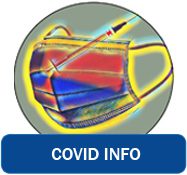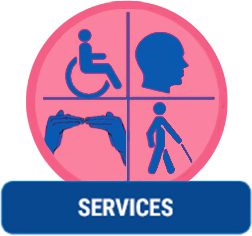Watch how to sign ‘Creator’ in American Sign Language
DAYLE MCINTOSH (1941- 1977) – Founder
 On a winter’s day in Vancouver, Canada, Dayle Irene McIntosh was born on December 3, 1941. She came into this world with a congenital condition which left her paralyzed limiting her physical capacity to the use of her thumbs and forefingers. She was a quadriplegic, but didn’t ever use that as her identification, rather self-identified as a person with a disability. This was how she approached important issues and topics later in life, letting her outgoing and unwavering personality shine ahead of how she was perceived.
On a winter’s day in Vancouver, Canada, Dayle Irene McIntosh was born on December 3, 1941. She came into this world with a congenital condition which left her paralyzed limiting her physical capacity to the use of her thumbs and forefingers. She was a quadriplegic, but didn’t ever use that as her identification, rather self-identified as a person with a disability. This was how she approached important issues and topics later in life, letting her outgoing and unwavering personality shine ahead of how she was perceived.
McIntosh also came into the world determined to overcome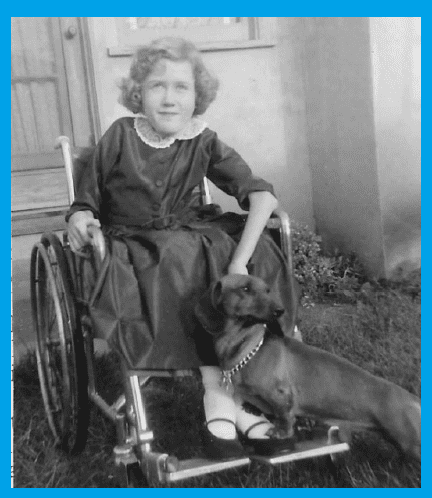 obstacles and was destined to be a community activist, a leader, and a person who would become the voice for people with disabilities. Although she died too soon at the young age of thirty-five, she accomplished huge feats, leaving her legacy as co-founder of the Dayle McIntosh Center, which carries her name as the Independent Living Center we know today.
obstacles and was destined to be a community activist, a leader, and a person who would become the voice for people with disabilities. Although she died too soon at the young age of thirty-five, she accomplished huge feats, leaving her legacy as co-founder of the Dayle McIntosh Center, which carries her name as the Independent Living Center we know today.
McIntosh would make her way to the United States with her family in 1952, where she landed in sunny California, , receiving an official letter from Congress of the U.S. House of Representatives, dated November 15, 1961 announcing her as a U.S. Citizen. After graduating from Whitney High School in Los Angeles, California, she wasted no time immersing herself into her educational pursuits attending Santa Monica City College, then becoming a University of California, Los Angeles (UCLA) Bruin, before heading to Cal State University Long Beach (CSULB).
A multitasking dynamo, Dayle had a background in business education and was an accountant and technical writer for computers, while simultaneously challenging the system – demonstrating that a person with disabilities can achieve a multitude of things! Ahead of her time, she could problem-solve through her own involvement, jumping in to be of service wherever she could. Her early community activism knew no limits fighting for the rights of people with disabilities during one of the most important developments in the disability rights movement. Though she persisted amid a tough journey, serendipitously she was ‘at the right place, at the right time,’ as the Independent Living Movement first took hold in the 1960s in California through the efforts of Ed Roberts at UC Berkley. Roberts was an inspiration for McIntosh at a time when she kept the passionate fires of her advocacy enthusiasm going to push forward. She attended many conferences, connected with local government, participated in rallies and joined numerous organizations aligning with her independent fiery spirit as the leader she would self-actualize by showing up when it mattered.
The period between the 1960s to1970s, McIntosh kept herself busy. She became a Member of the Grey Panthers, an activist organization confronting ageism and social justice issues, and in her short lifetime added numerous roles to her community activist resume becoming a member of Orange County’s Human Relations Committee, advocating for the disabled, while being an advocate for client rights at Fairview State Hospital in Costa Mesa. She was also a key Correspondent for the New World newsletter.
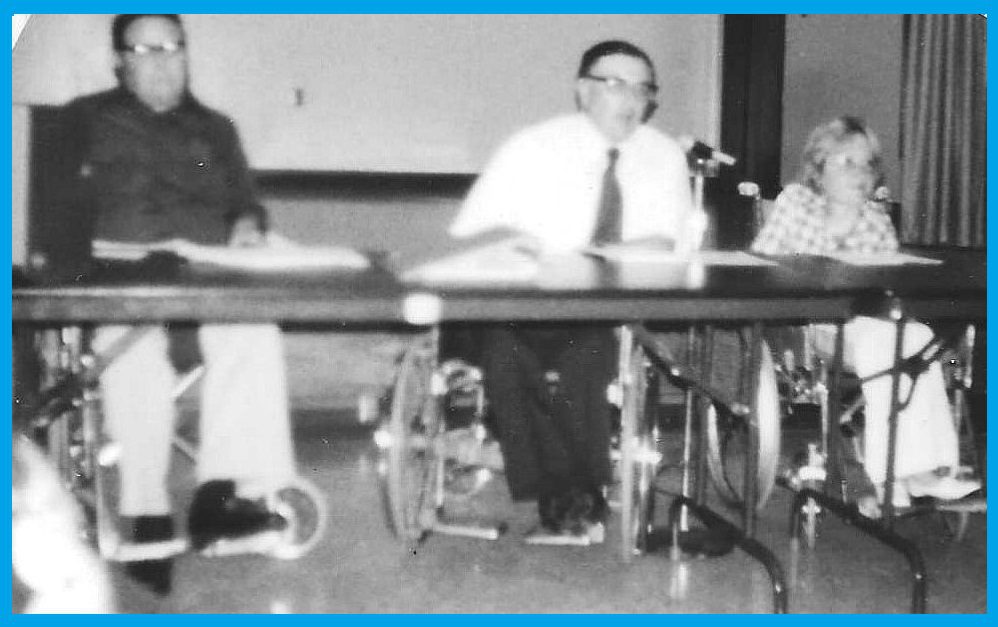
In 1973, she joined the local chapter of the California Association for the Physically Handicapped (formerly, CAPH). It was here she met and became good friends, colleagues and a partner activist with Mick Spencer, one of the original founders of the OC Chapter of CAPH. For years, she was the editor of the Orange County Exchange Newsletter, serving the chapter to inform and educate everyone this publication reached. McIntosh would write about the issues the disability community faced. She covered the spectrum of politics, day-to-day accessibility, social issues and more! McIntosh also became friends with Mick’s wife, Leona Spencer who was CAPH Treasurer.
Keeping her nose to the grindstone, McIntosh didn’t know while she was working hard in the early days as writer and newsletter editor that Spencer would take on other roles within the organization. He was grooming her to take his place as President for CAPH OC Chapter as he went on to become CAPH State Vice-President. She eventually would become the organizations District Director and President. However, passing the torch didn’t mean the end of their activism. It was just the beginning. From a California seat position and McIntosh as President, they could leverage important issues which mattered most to the community – both speaking, and McIntosh wearing many hats, still sharing her voice in writing with her mighty pen. She kept going… and soon Spencer and McIntosh
would be working together again in a different context, as Spencer became part of the City of Huntington Beach’s Design Review Board.
FOUNDATIONAL STEPS BECAME RAMPS
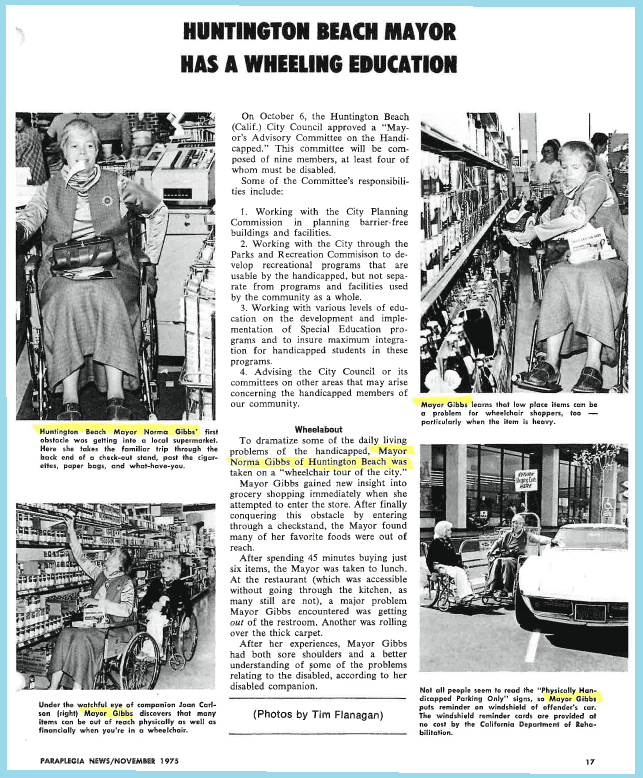
This news article from November 1975 from Paraplegia News announces Norma Gibbs’ approved Advisory Committee for the Handicapped, in which Dayle McIntosh was the first Secretary. For Gibbs to understand McIntosh’s daily life, Gibbs experienced life in a wheelchair to understand what work needed to be done to access the city with daily tasks such as grocery shopping, witnessing others violate the handicapped parking space and more. This real-life research set the foundation for accessibility need.
October 6, 1975 was when McIntosh ended up taking on the position of Secretary to Huntington Beach’s first-woman Mayor Norma Gibbs’ advisory committee on the Handicapped in Huntington Beach. McIntosh’s strength, tenacity and influence was inspiring to Gibbs – so much so that Gibbs wasted no time – and spent a day in a wheelchair to learn the day-to-day life of lived experience trying to get around town. This helped create a better ‘understanding’ of what McIntosh brought forth in important needs/issues for the disability community.
 Brenda Premo was coming into her own. As a blind woman with Albinism, she was determined to get her own voice heard in the name of others. She had joined CAPH and headed up the Diablo Chapter. Premo was working with her old high school Marina High School Psychology Teacher, Allan Kennedy – the one who inspired her to go to Golden West College where she learned ASL, and where Kennedy also, eventually was a teacher. Then Premo was off to Cal State University Long Beach, where Dayle had attended, but their timeline missed one another!
Brenda Premo was coming into her own. As a blind woman with Albinism, she was determined to get her own voice heard in the name of others. She had joined CAPH and headed up the Diablo Chapter. Premo was working with her old high school Marina High School Psychology Teacher, Allan Kennedy – the one who inspired her to go to Golden West College where she learned ASL, and where Kennedy also, eventually was a teacher. Then Premo was off to Cal State University Long Beach, where Dayle had attended, but their timeline missed one another!
Timing had finally aligned for Dayle McIntosh and Brenda Premo to meet. Both McIntosh and Premo wore many hats at CAPH. McIntosh was part of numerous chapter tasks, not just as a leader, a writer, a speaker, and bridge communications facilitator, she was also responsible for shedding light on political initiatives.
Premo was doing the same through surveying as CAPH’s Education Chair. McIntosh interviewed Premo and penned this article, which became their forceful onramp to collaboration, the bridge and the connection that would create a spark at OC Board of Education. This survey and other surveys would lead to what would become the groundwork for DMC.
This initial bond was an interesting one. Their paths had crossed through different people, but they had not met before this time. CAPH was the introduction. City of Huntington Beach would be the next upcoming chapter where they would create history together.
Merging their experiences, McIntosh and Premo collaborated to illuminate accessibility issues to Norma Gibbs, allowing her to gain an understanding of the genuine voices within the disability community through their collective efforts. With Premo’s existing acquaintance with Gibbs and McIntosh’s connection through their shared work, this became another enlightening “Ah ha moment,” revealing more commonalities between them—be it in people, places, connections, and community.
McIntosh and Premo understood this was merely the start of their working together, they would be poised to take on what was in store for them next – something even bigger to tackle that would literally cement their concrete bond… curb cuts. They were asked to work on a project to help make an entire city accessible. Premo coordinated the plan in alliance with CAPH. McIntosh (CAPH Editor) and Mick Spencer (OC CAPH Founder and President) – were wearing both of their hats between the organization as the link pin to the City of Huntington Beach. Spencer also happened to be on the Huntington Beach Design Review Board, as McIntosh was on Gibbs’ Advisory Committee. The three musketeers made headlines.
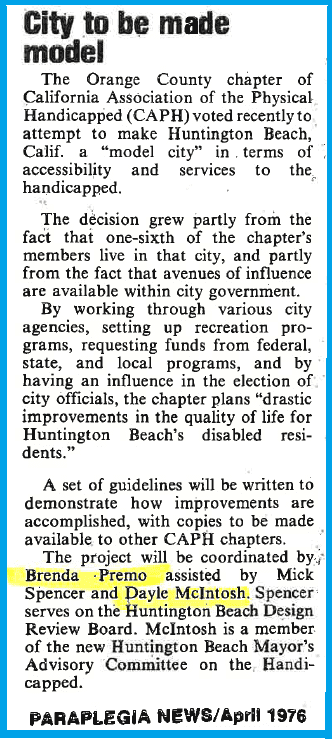 This project took some time, demanding many city council meetings, plans, and huge decisions. This would involve assessing how to make improvements… and there were so many to make Huntington Beach a flagship city for the disabled.
This project took some time, demanding many city council meetings, plans, and huge decisions. This would involve assessing how to make improvements… and there were so many to make Huntington Beach a flagship city for the disabled.
McIntosh was moving full-speed ahead with this ‘development in the works’ also took the reins becoming a CAPH convention co-chair, and in 1976 was able to rally the troops of the membership of 2,400 people to attend).
She has been called a taskmaster, someone who could get things done. Brenda Premo’s. High school Psychology teacher Allan Kennedy was Council Mayor’s Committee Chairman in Huntington Beach local government working to help disabled job seekers. Kennedy and Spencer, were key to Premo and McIntosh finding each other. He not only worked with CAPH across many events, but would end up serendipitously helping later being the bridge of education for DMC.
These early seeds McIntosh was planting with the City of Huntington Beach were meaningful. Kennedy called her ‘an evangelist and a crusader for equality.’ Pam Mammet said she had ‘encyclopedic knowledge and had a strong concern for human rights.’ These were people who knew her tireless efforts doing all she did, they were also fortunate to call her a friend, an artist, a committed individual … with countless talents, strengths and much passion. She was fun, had a sense of humor and had a carefree social side – balancing work and play. Though she was a true work horse and was guilty of having the scales tipped to her community activism much of the time due to her ‘living a purposeful life nature’ and always wanting to be of service.
1976 was the pivotal year. McIntosh and Premo had a lot in common, actively participating in the CAPH organization destined to meet to carry out more than just what they did.
The original survey bringing McIntosh and Premo together was fronted by Premo and Orange County Board of Supervisor’s Greg Winterbottom, a paraplegic who was vigorously fighting for handicapped parking rights. Premo was involved with the Comprehensive Employment Training Act (CETA), appointed to conduct a report and build an organization to address disability community issues. The Huntington Beach Community Development Block Grant was available and CAPH had a foundation allowing McIntosh and Premo to start an Independent Living Center.
McIntosh and Premo mirrored community activism agendas, resources, grit, creative forces and matched wills of Winterbottom’s fierce persistence equaled ‘finding a way.’ The open door was appearing, though it would take a lot of work. McIntosh herself had a lot of plans for the community, the people to be served and the only desire she had for herself was to be the bookkeeper of the IL Center and know that the organization would be providing programs and services that she and Spencer already knew how to do. McIntosh paid close attention. She was there when the OC Chapter of CAPH was forming and witnessed how they were able to move things forward. She had made a lot of connections, met a lot of people, wrote about many important issues and now Premo was in the picture armed with an army of the same.
Together they would intertwine the network city governments, educators, OC Board of Supervisors, recreation programs and planning officials. This was the beginning of a collaboration which would soon create history with an independent living center. Gibbs would be instrumental for more introductions, and government access as Dream Team DMC began to take shape and dared to make the impossible possible.
McIntosh and Premo’s milestone-in-the-making entailed bringing forth initiatives, unifying key disability activists and groups, applying for government grant funding with outreach toward a network of like-action pioneers matching their desire for the creation of this dream Independent Living Center.
The center’s framework followed the sparked inspiration operation of the Berkley Center for Independent Living from 1972, which Premo had visited in-person along her own activism journey, along with Los Angeles’ Westside Independent Living Center. McIntosh had wanted to be the bookkeeper for the new organization ‘in-the-works’ as the two dreamed they could see their concept through to fruition.
The nine-month OC Human Relations Commission survey was in the works, underway and the kismet of timing, funding, and opportunity appeared to be lining up toward success.
In January of 1977, McIntosh was rallied around in support in the biggest way for the year ahead where her dreams would be realized. She had big plans. Her own parents, Fred and Irene McIntosh, along with Greg Winterbottom (who would end up being President of DMC’s Founding Board of Directors) joined CAPH at the start of the brand new year. It was a year of progress, hope, and inspiration.
Most people who did know Dayle have described her as someone who lived a balanced life of activism and social enthusiasm in the same breath. She loved to create, and was quite the crafter with a very artistic nature, ability to visualize something and bring it into reality. Her creative soul had a passion for social storytelling, but she equally loved to write about important injustices, but in such a way that made one think twice by injecting her own flair for sharing topics in a conversational way.
Calm, sweet and fair – she could also get riled up to ‘tell things like it is’ without apologizing for being honest, standing in her truth. These were qualities most admired about her. She was an ‘involved’ editor overseeing the CAPH Newsletters and writing up a storm in the 1960s… soon she could potentially be penning those of The Dayle McIntosh Center for the Disabled, an independent living center which seemed close within reach.
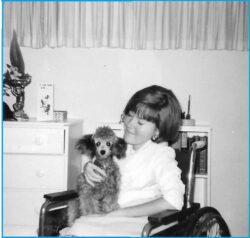 When she took her time to socialize, spend time with friends, enjoy a meal, flirt with nature, people, animals or destiny, there was a charm about her that did not go unnoticed. She cared about everyone and everything.
When she took her time to socialize, spend time with friends, enjoy a meal, flirt with nature, people, animals or destiny, there was a charm about her that did not go unnoticed. She cared about everyone and everything.
McIntosh’s active mind, inner strength, tenacity and progressive thinking brought about awareness for the needs of the disability community, but it was her own voice that changed the way people viewed programs and services to be provided on a cross-disability basis, urging the government to meet vital needs. Always problem-solving with new ideas, using her intelligence, wit and motivational spirit, she was determined to meet all challenges head-on. This was her plan for DMC.
From her long list of accomplishments, positions, experience and activism work, she persisted in breaking new ground and finding opportunities to be of service. As a curious person, she liked to actively make things happen, participating wherever she could.
Framework continued to take shape in building the DMC Dream Team. Winterbottom would become Chairman/President. Vice-President, Geno M. Vescovi, Governance/Secretary, Paul M. Culton, and Treasurer, Tadashi (Tad) Tanaka rounded out this Board. Other Board Member At-Large Leads included Ruth Finley, Peggy Metro and Don A. Nelson included on the Original Articles of Incorporation. Application filing was sent via snail mail.
Unfortunately McIntosh passed away August 5, 1977 just before the center’s doors could “officially” open with funding for her to see her dream realized. Twenty days after her death, the grief felt within the community was so deep. Her memory was highly regarded and respected.
The Official Proceedings of OC Board of Supervisors adjourned their meeting early in honor of her memory on August 25, 1977, and it was published in the newspaper:
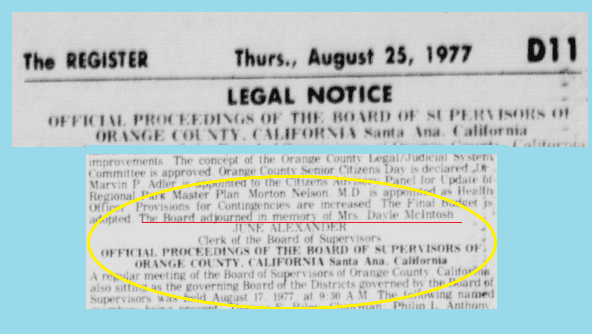 After incorporation papers had already been filed, and Dayle had passed away, Premo soldiered on, bringing in additional support with Mick Spencer, who knew Dayle best, and Kay Goddard who was her CSULB ‘cheerleader’ encouraging her in her endeavors. They would be lassoed in by Premo to join the inaugural Board of Directors with key support, with Spencer specifically (having worked so closely with Dayle) being in charge of the program development and insights for infrastructure would progress.
After incorporation papers had already been filed, and Dayle had passed away, Premo soldiered on, bringing in additional support with Mick Spencer, who knew Dayle best, and Kay Goddard who was her CSULB ‘cheerleader’ encouraging her in her endeavors. They would be lassoed in by Premo to join the inaugural Board of Directors with key support, with Spencer specifically (having worked so closely with Dayle) being in charge of the program development and insights for infrastructure would progress.
On the opening day of DMC – Brenda Premo was the Executive Director, Darlene Garrison, Information and Referral Specialist, Bob Cummings Administrative Analyst, Jack DiGaetano, Outreach Worker and Yvonne Bagstad took the role of bookkeeper, the role that McIntosh had initially dreamed of having for herself. This was Team DMC as the working team of staff, alongside the original Board of Directors.
The group would actualize The Dayle McIntosh Center in 1977, one of the now 28 Independent Living Centers in the State of California.
McIntosh’s tireless work and arduous trek to build the foundation and framework with Brenda Premo and the DMC Dream Team was enough to actually bring the dream into fruition, in her honor.
McIntosh was also CAPH Convention chair – a position she held until the time of her death in August with pre-laid plans for 1978’s conference. This work was part of the hub for the above mentioned woven web of people, who could end up carrying out well-laid plans in Dayle McIntosh’s name.
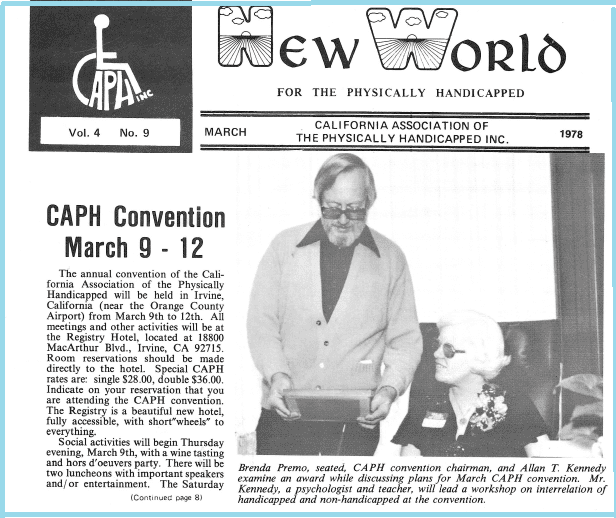 Determined to do right by McIntosh’s well-laid plans for the CAPH convention, Premo wasted no time, taking the position of Convention Chair to make sure McIntosh’s plans, ideas and creativity would be honored and seen through to come to life just as Dayle envisioned.
Determined to do right by McIntosh’s well-laid plans for the CAPH convention, Premo wasted no time, taking the position of Convention Chair to make sure McIntosh’s plans, ideas and creativity would be honored and seen through to come to life just as Dayle envisioned.
Premo successfully enlisted Peggy and Theresa Metro from the Beachwood CAPH Chapter, now integral members of the DMC family. Peggy takes on the dual role of Office Manager within DMC and serves as the Finance Chair on the Board of Directors. Together, they contribute their efforts to breathe life into panels, workshops, and various promotional initiatives. Additionally, Premo, in a full-circle move, sought the guidance of her mentor and Dayle’s avid supporter, Allan Kennedy, returning the favor by leading a workshop at the conference.
The Center was named after Dayle McIntosh in honor of her independence, fight, spirit, intelligence, and philosophy, which is now her lasting legacy, an organization which represents her vision of community. The Dayle McIntosh Center, CAPH organization and many of Dayle’s personal passion projects were fully supported by her parents, Irene and Fred McIntosh. They both continued to support the DMC organization in all the ways they could through events, fundraising, and even outreach to other independent living centers carrying forward important communications channels as Dayle would have done. Irene took pen in hand herself to contribute toward both CAPH and DMC’s articles and Premo remained grateful for their continued support with all of the center’s activities and events.
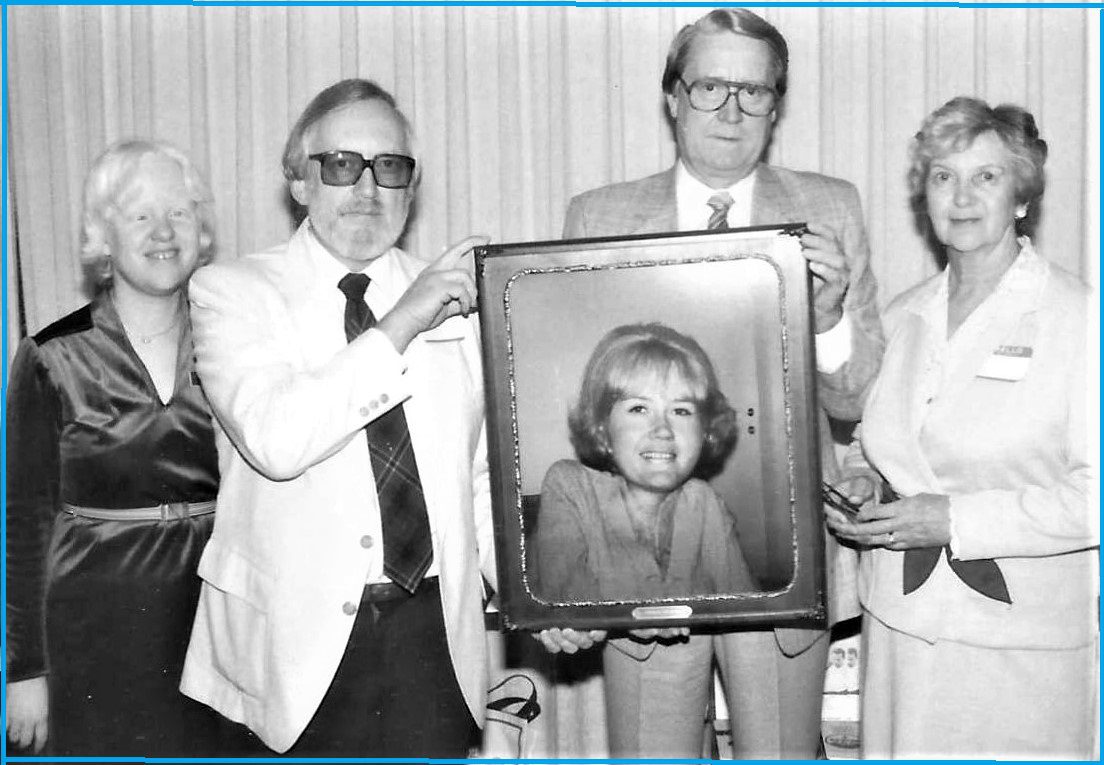 Irene and Fred McIntosh were very proud of their daughter. She was a light who shined brightly. They not only raised her to be a confident child who took risks but they also learned from their daughter’s tenacity and strength as well, which further inspired each of them in their own golden years to know just how Dayle’s spirit continued to inspire people, communities, and other leaders.
Irene and Fred McIntosh were very proud of their daughter. She was a light who shined brightly. They not only raised her to be a confident child who took risks but they also learned from their daughter’s tenacity and strength as well, which further inspired each of them in their own golden years to know just how Dayle’s spirit continued to inspire people, communities, and other leaders.
The City of Huntington Beach awarded Dayle McIntosh with a posthumous award which they accepted on Dayle’s behalf.
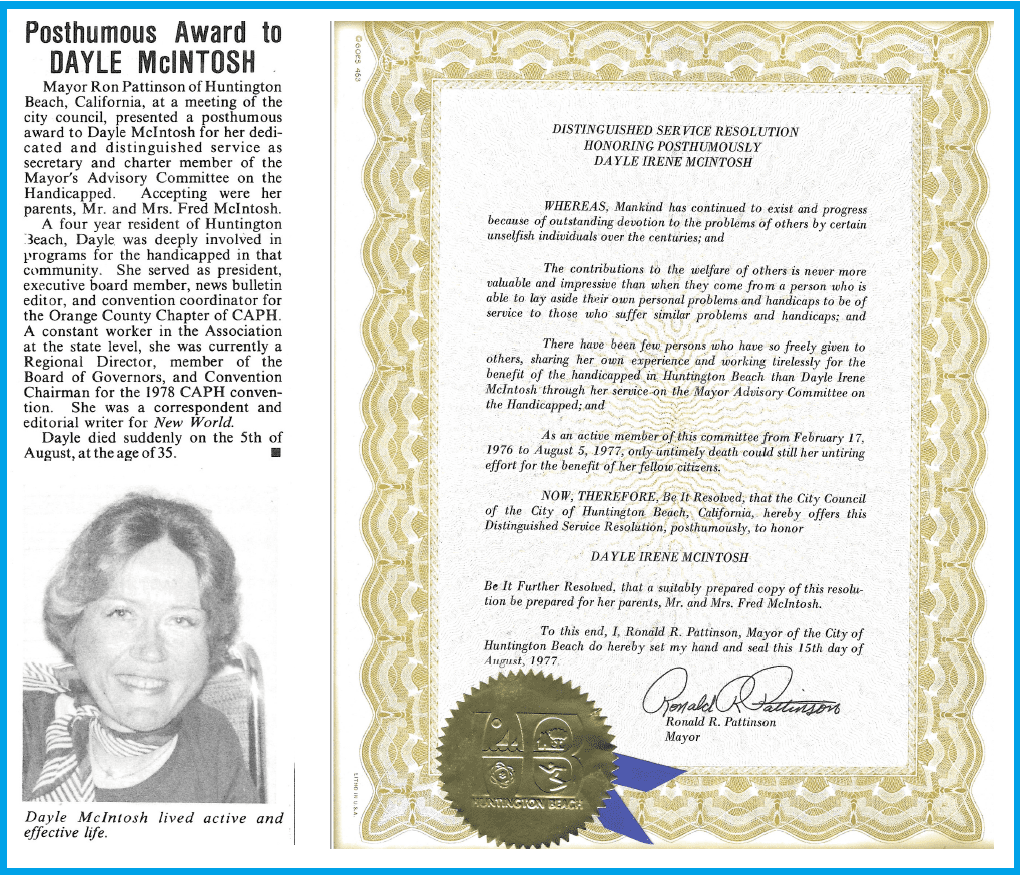
Proclamation reads:
WHEREAS, Mankind has continued to exist and progress because of outstanding devotion to the problems of others by certain unselfish individuals over the centuries; and
There have been few persons who have so freely given to others, sharing her own experience and working tirelessly for the benefit of the handicapped in Huntington Beach than Dayle Irene McIntosh through her service on the Mayor Advisory Committee on the Handicapped and
As an active member of this committee from February 17, 1976 to August 5, 1977, only untimely death could still her untiring effort for the benefit of her fellow citizens.
NOW THEREFORE, Be it Resolved that the City Council of the City of Huntington Beach, California hereby offers this Distinguished Service Resolution, posthumously, to honor DAYLE IRENE MCINTOSH.
Be It Further Resolved that a suitably prepared copy of this resolution be prepared for her parents, Mr. and Mrs. Fred McIntosh.
To this end, I Ronald R. Pattinson, Mayor of the City of Huntington Beach do hereby set my hand and seal on this 15th day of August 1977.
Ronald R. Pattinson
Mayor
Dayle Irene McIntosh isn’t just our founder, she is the heart of the Dayle McIntosh Center. Her legacy lives on in the work we do in her memory. We never forget her sacrifices and community activism, her long hours and her fight. She taught us what service means and it is in this, we say together we are DMC.




